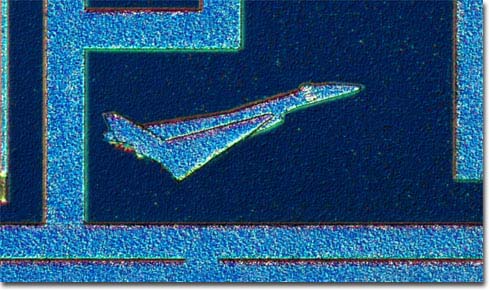World's Tiniest Concorde (or is it a Valkyrie?)
|
This miniature rendition of the world-famous Concorde jetliner was discovered in a holding pattern near the pad ring on an Advanced Micro Devices MACH445-12YC programmable logic device (integrated circuit). Measuring about 100 microns from nose to tail, this silicon doodle is no doubt the smallest version of the plane made to date. Many of our visitors have pointed out that the silicon airplane on this chip is more likely an experimental United States Air Force bomber known as the XB-70 Valkyrie. After examining photographs of the Valkyrie, we think they are probably right. Shows how much we know about airplanes. The Concorde was the world's first supersonic commercial jet to be used on a regular, if limited, basis. The first test flight of the jet was in 1969 and the first commercial flight took place in 1976. Only 16 aircraft were ever produced, 13 of which were purchased and flown by two airlines, British Airways and Air France. In 1975, other airlines dropped their options to purchase Concordes, concerned that they would be too expensive to fly. The jet consumed far more fuel than other jets, carried few passengers, and its high noise level, from massive engines and sonic booms, restricted it from flying over land. Restricted to transoceanic flights, the Concorde has never been profitable to fly. Nonetheless, since 1976, the Concorde has been the aircraft of choice for the rich and famous, enticed by the slogan, "Arrive before you leave!" and VIP services. Passengers could sip champagne, dine on gourmet food and enjoy every convenience - except movies. When the jet was first built, a movie projection system would have made it too heavy. And the speedy jets did, in fact, arrive before leaving -- if traveling in the right direction. Flying from New York to London at 60,000 feet with a cruising speed of Mach 2 (1336 mph), the Concorde crosses five time zones (setting the clock back five hours) in just three and a half hours. The Concorde holds the world record for the fastest crossing of the Atlantic by a passenger airliner, flying from New York to London in 2 hours 54 minutes and 45 seconds. The chip containing this artwork was loaned to us by Chipworks, a company that is an international provider of reverse engineering services, analyzing the circuitry and physical composition of semiconductor chips and electronics systems for competitive study, intellectual property support, and reliability assurance. |
© 1995-2025 by Michael W. Davidson and The Florida State University. All Rights Reserved. No images, graphics, software, scripts, or applets may be reproduced or used in any manner without permission from the copyright holders. Use of this website means you agree to all of the Legal Terms and Conditions set forth by the owners.
This website is maintained by our
|
